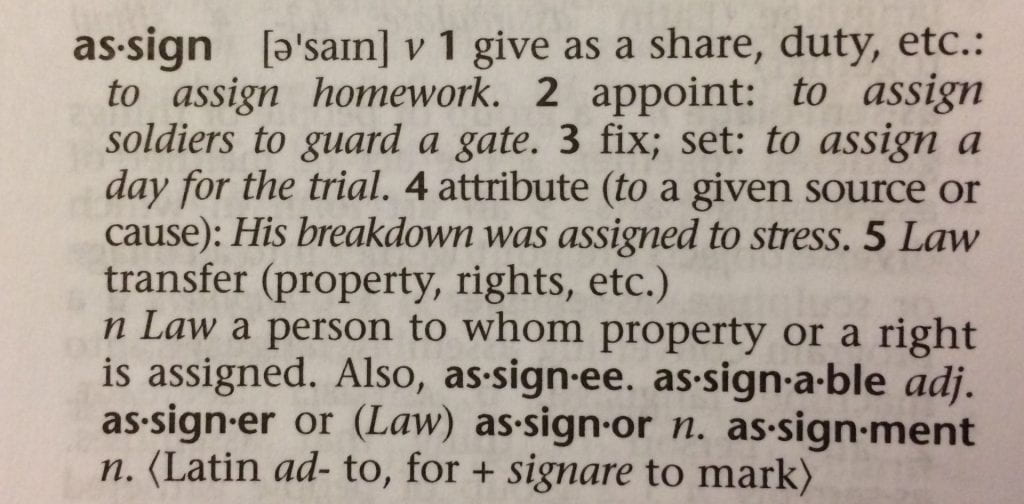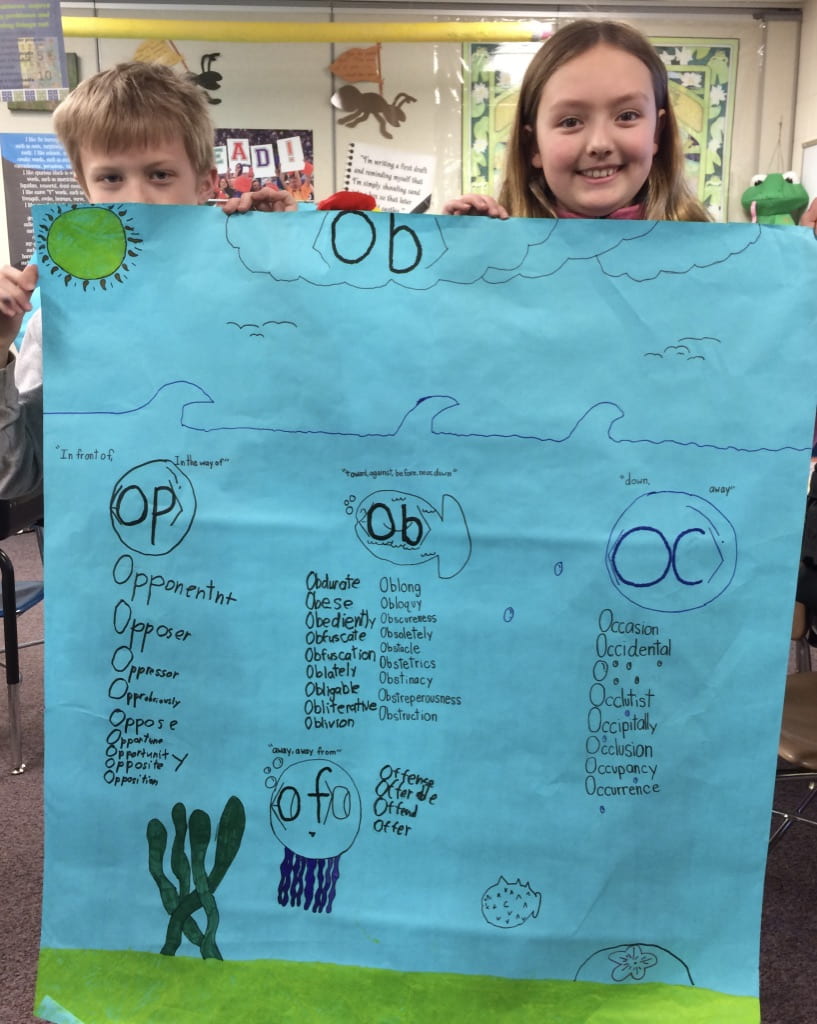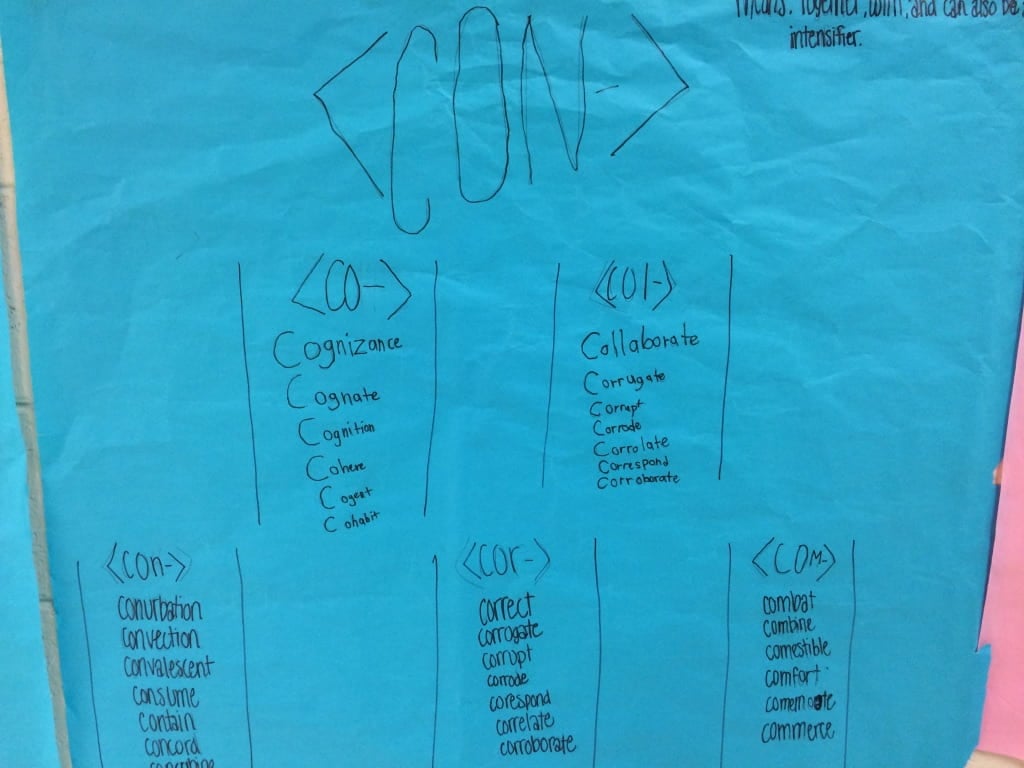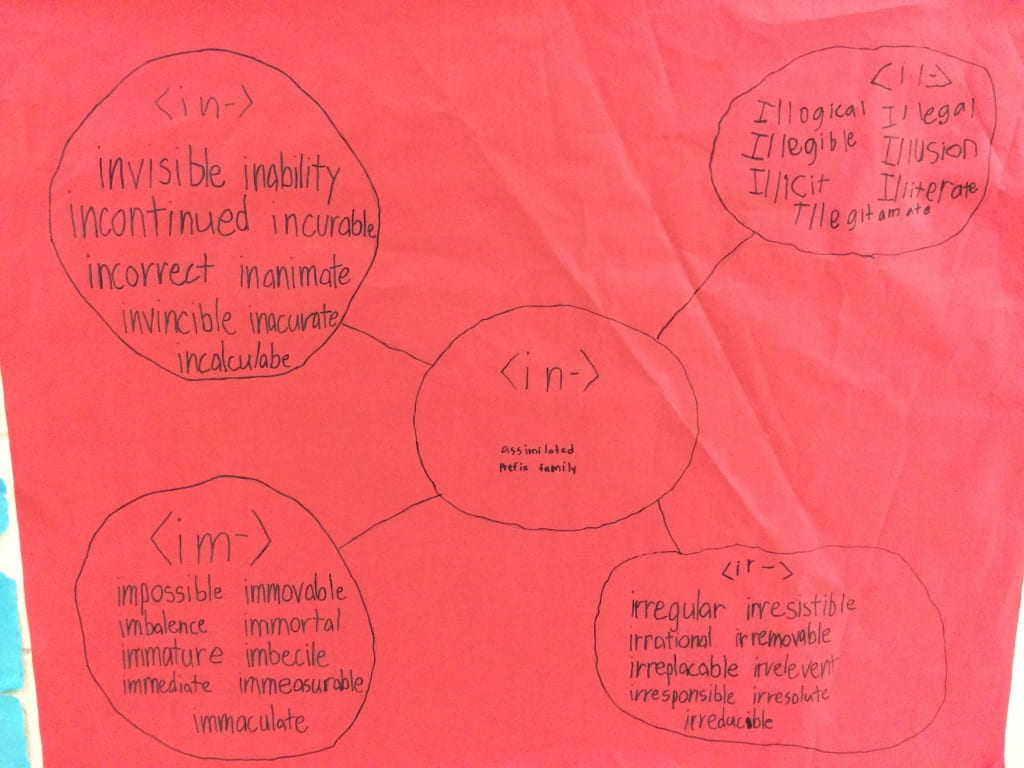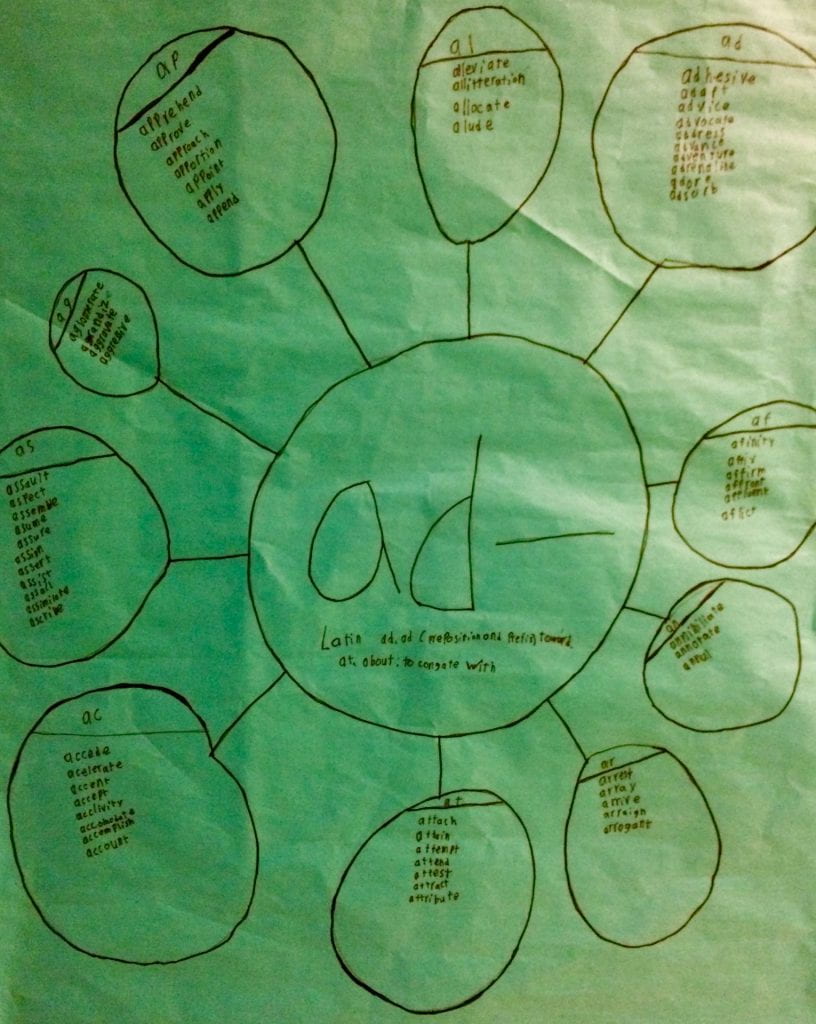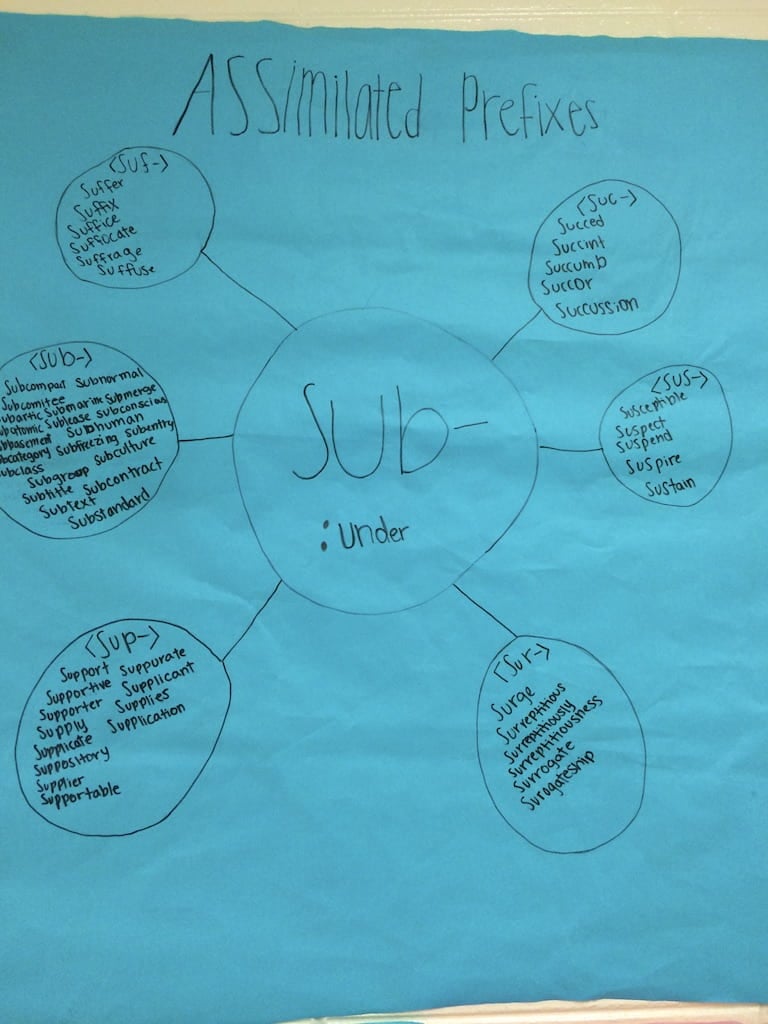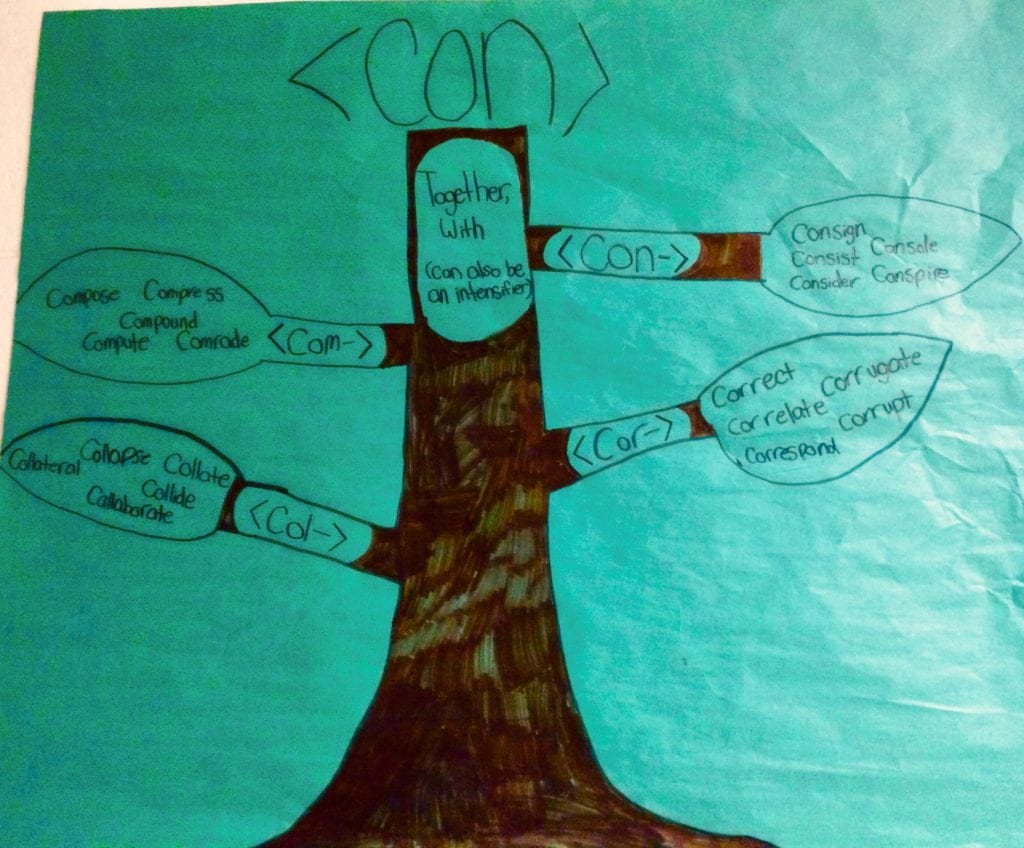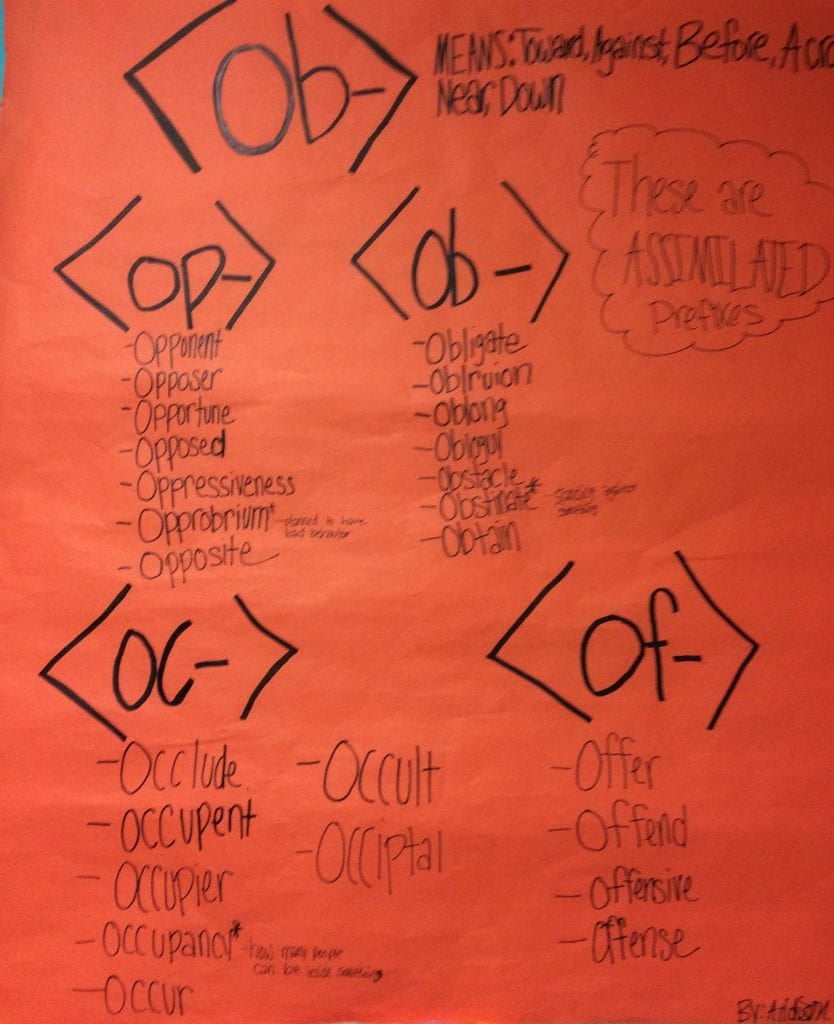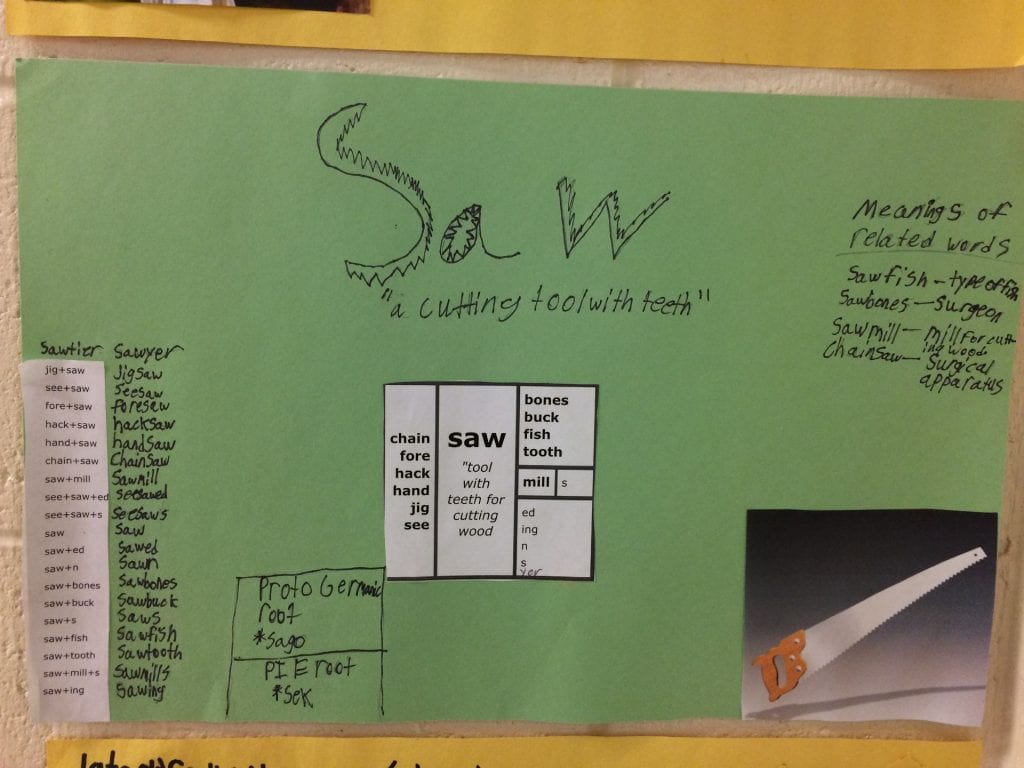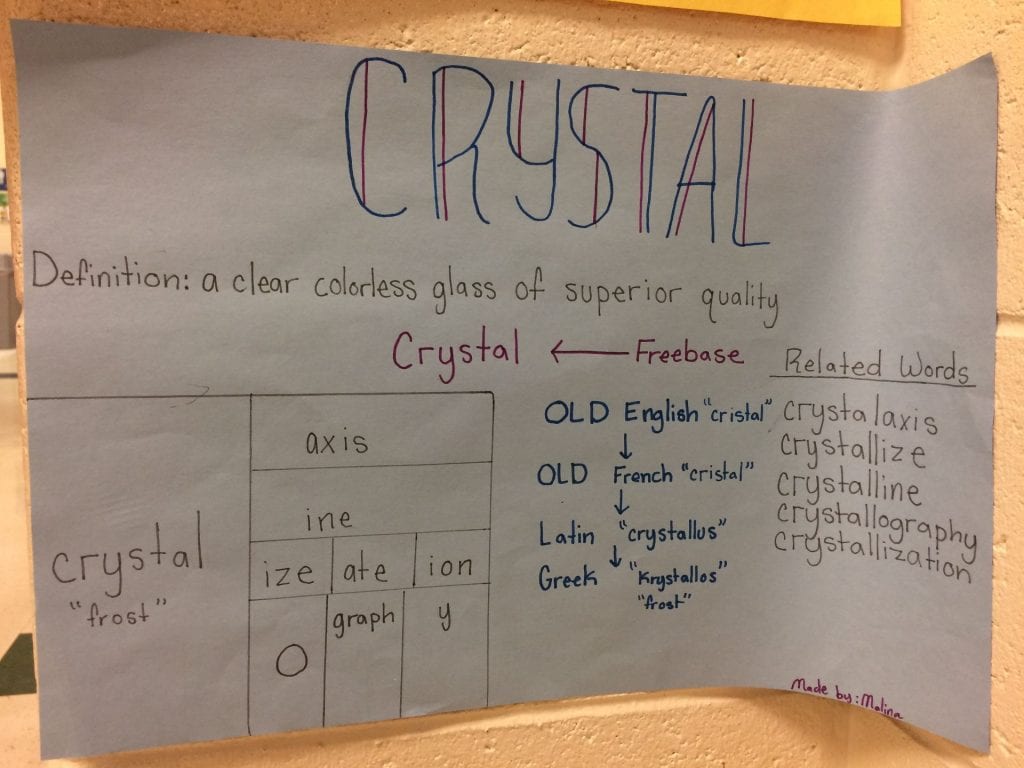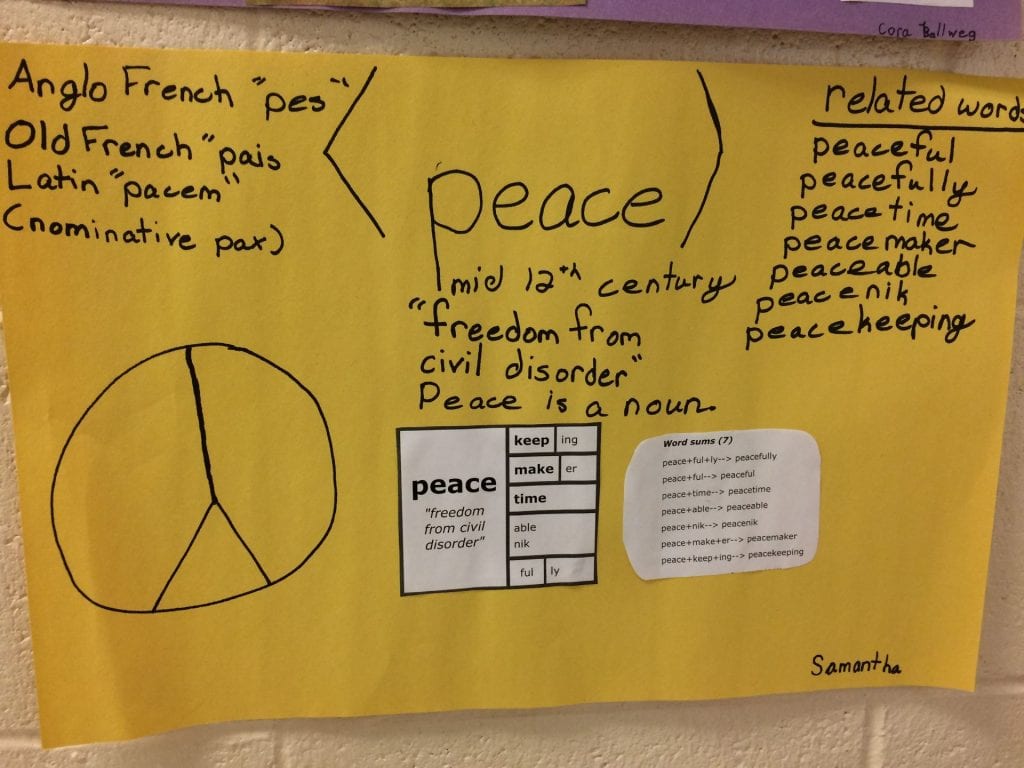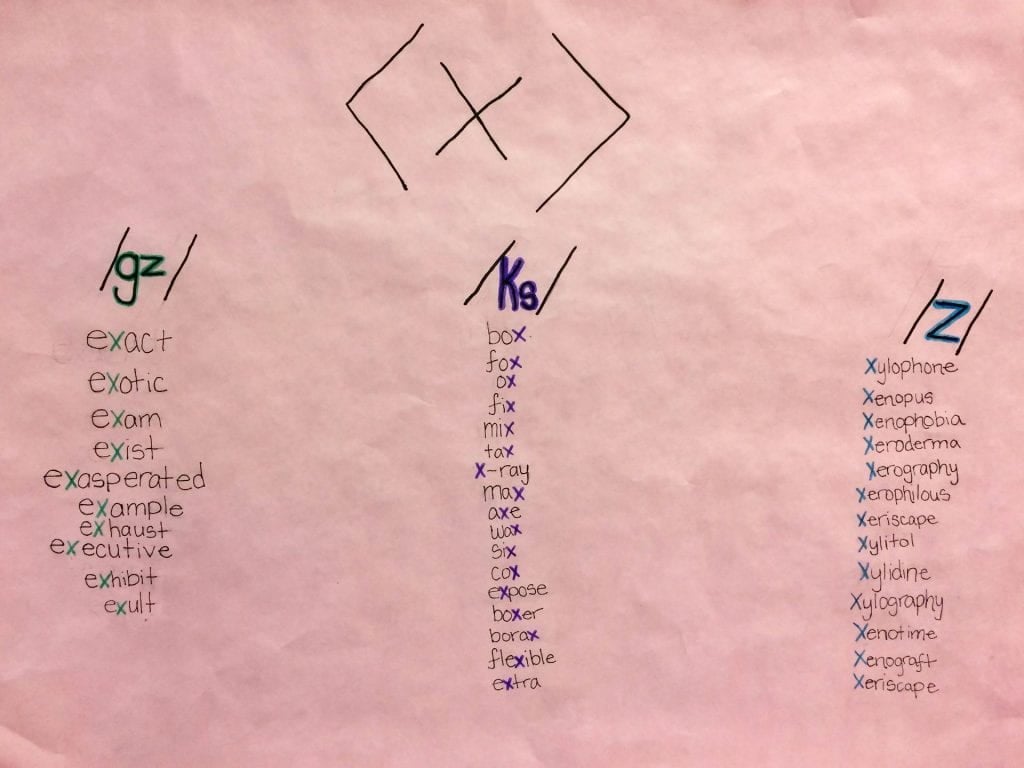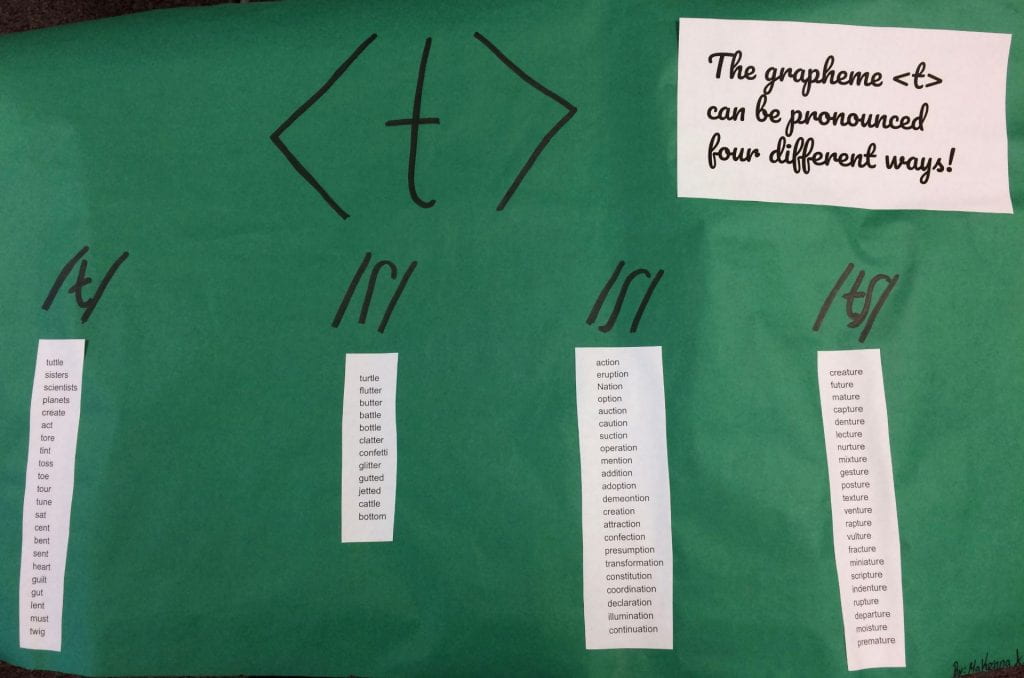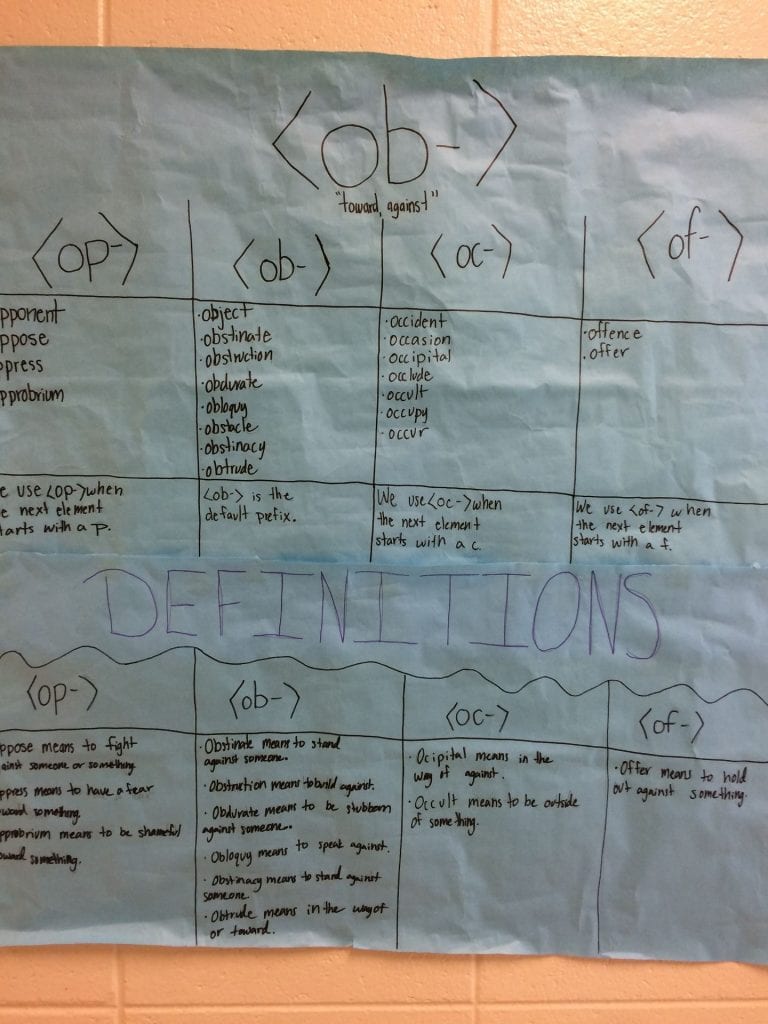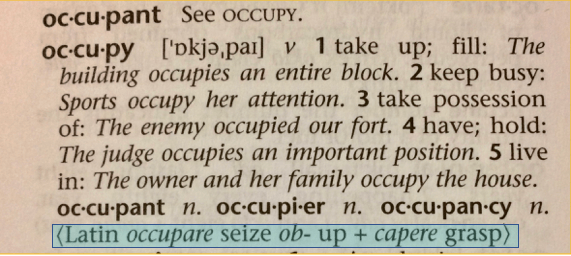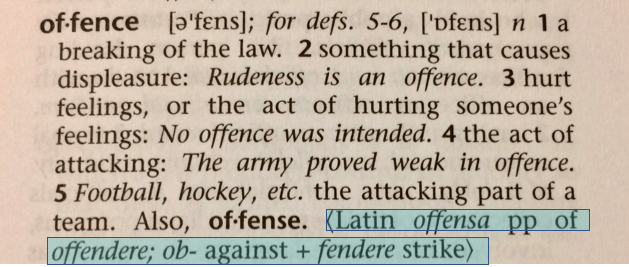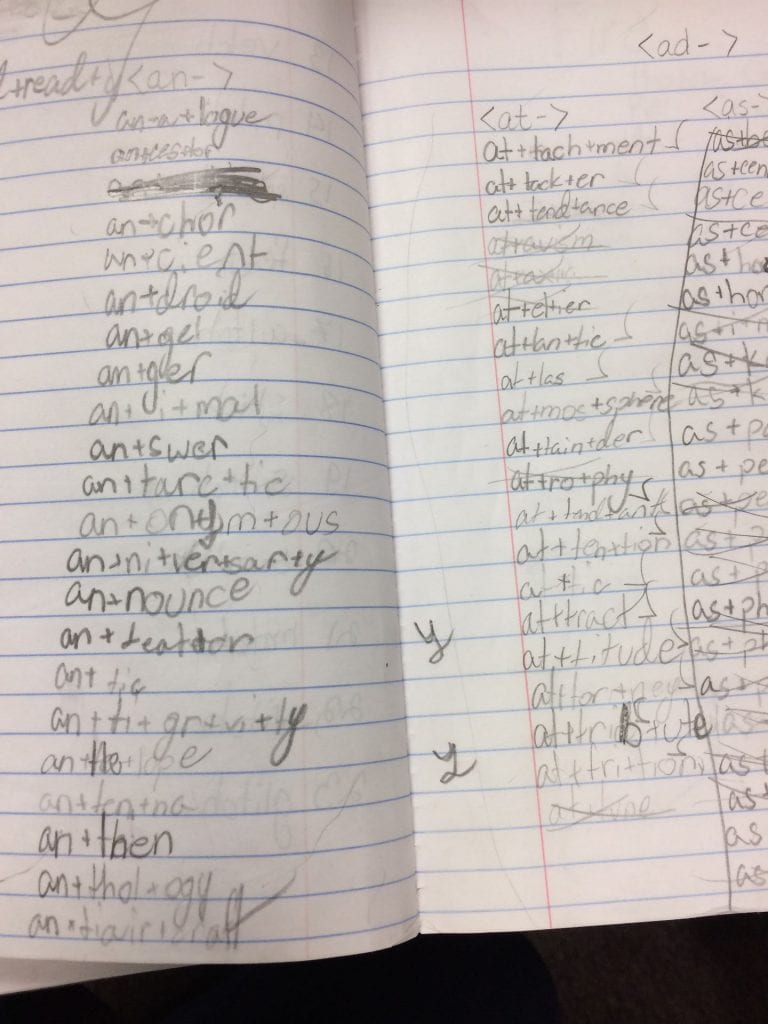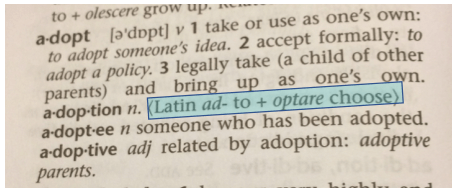When school was abruptly closed this year, we were in the middle of many great projects. The biggest of those focused on assimilated prefixes. The students had spent time either individually or in small groups looking at a particular prefix and its assimilated forms. What ended up being a good thing is that not everybody started this project at the same time. It was one of those classroom situations that happens when certain students finish what they are working on sooner than other students and ask about something new to do. The first few students ended up working alone. I had them take a look at a specific assimilated prefix.
For instance, I assigned the first student looking for something new to do the prefix <ad->. I asked him to find words that clearly had an <ad-> prefix. That meant that he couldn’t just go to word searcher or a dictionary and write down words that begin “ad…” He had to check their etymology to make sure they had the <ad-> prefix joined to a base. When he brought a list to my desk, I asked him what sense the prefix often brought to the words he had listed. We looked over the list together and talked about what the words meant.
This step is important to me. If you look at the student posters below, you will notice that the students tend to add words to their list that are not words that a fifth grade student might typically use. It is as if they open the dictionary and copy the first bunch of words they see, not even entertaining the thought that there might be words that fit the search that they already know. Of course I encourage them to first look for words they know, but looking at words without considering what the word means is something that they’ve been doing a lot of prior to fifth grade. It’s a habit, unfortunately. So I counter that habit with continually asking what the words they choose mean. Then when these posters are presented to the class, we go over the unfamiliar words again. Having said that, I have no intention of testing them on any of these words. I am well aware that in a week they may not remember what some of these words mean, and that’s okay. They will remember some of them and really, the point here is to notice and become familiar with the prefix. When they see a word in the future that begins with an “ad…” I want them to be able to consider whether that is functioning as a prefix in that word or not. If they think it is, based on what else they recognize in the spelling, then they will know that it brings a sense of “to” to the base. It is a valuable consideration when thinking about a word sum hypothesis.
Besides possibly noticing this prefix on some word in their future, there is another underlying foundational concept that we are reinforcing when we talk about what the words we are collecting mean in relation to the base and in relation to the prefix. That underlying concept is the fact that words that share bases or share affixes, also share something in their sense and meaning. When the students really understand that, they will begin to look for that shared sense or that shared meaning. The fact that students have not been taught that words like design and signature share a base and therefore a meaning is such a lost opportunity! They don’t expect two words to be related or connected in meaning unless they are exactly the same, except for maybe a switch-out of suffixes. So, for instance, a student would expect signature and signatures to be connected in meaning, but not signature and signal.
After the student had collected words with an <ad-> prefix, he asked what to do next. So I told him that the <ad-> prefix has some assimilated forms. I told him that sometimes the <ad-> form doesn’t work so well as it gets paired up with certain bases. As an example, we looked at the word “assign.” The prefix on this word is an assimilated form of <ad->. It is <as->. It’s really the same prefix as <ad-> and brings the same sense of “to” to the denotation of the base. He looked puzzled, so I asked the question for him, “Why don’t we just use <ad->?” Well, look what happens when we try. Pronounce the base with an <ad-> prefix instead of the <as-> form. We both said *adsign. Then we kept repeating it until we could feel the /d/ assimilating to an /s/. I explained that what happened was that the /d/ assimilated to better match the articulation of the /s/ which is the next element in the word. Then I wrote out the word “assimilate” for him. I said, “Guess what the prefix is in this word?” He guessed the <as>. “Right. It is an assimilated form of <ad>! Do you recognize a familiar suffix at the other end of this word?” He recognized <ate>. That left <simil>. I told him the denotation of this base is “resembling, of the same kind, to make similar.” So what is happening here is that the /d/ in the prefix is assimilating to be more similar to the initial pronunciation in the next element. In this word, it assimilates to /s/! It was time to send him on his way to find words with an <as> prefix that had assimilated from an <ad> prefix. I asked him to grab one of the Collins Gage Canadian Dictionaries off our shelf. I wanted to show him exactly what he would be looking for in order to know if the initial <as> in any word he found was actually an assimilated form of the <ad> prefix.
I had him look for the word “assign” since we had just talked about it. The very last line of this entry had the information were looking for, Latin <ad-> “to, for.” That is the evidence I want all the students to look for when they find a word and are looking to see if it has an assimilated prefix. In this case, <ad-> is what I like to frame as “the head of this prefix family” or the default form of this prefix.
So now this same student was off to collect words with an <as-> prefix. Each time he came back, we looked over his list and I gave him another assimilated form for <ad->. He was quite surprised at how many there were!
The same conversation took place with other students in the other classes. Eventually I had all students looking at either <sub->, <con->, <ex->, <ad->, <in-> “not, without”, <in-> “in”, or <ob-> and the assimilated forms for each. Once their initial task of collecting some words with each of the assimilated forms of a specific prefix was completed, then I talked once more with them about this idea of assimilation. I wanted to make sure they understood how recognizing an assimilated prefix would be helpful to them. I also wanted them to have a sense that when an assimilated prefix is used, there is often the appearance of a doubled consonant near the beginning of the word. When they notice that, they will want to see if what they are really looking as is an assimilated prefix (one that has adjusted to match the beginning of the base). Next they made a poster of their findings. These were shared with the rest of the class so that students would be aware of prefix families other than the one they investigated. After the presentations and discussions, the posters went out into the hall. Here are a few of the posters.
When you look at these posters, you’ll notice the one main prefix with all of its assimilated forms. You may also be wondering again what makes these assimilated. You heard an explanation with the <ad-> prefix, but here’s a similar explanation using the <sub-> prefix.
Assimilation is what happens when the articulation of a sound is modified to better match the articulation of an adjacent sound. Assimilation can happen in other situations as well, but for now I am focusing on prefixes and bases. When looking at prefixes, I’m focused on the neighboring elements and what has happened over time as they were articulated. For example, let’s look at the word “supply.” If you look in an etymological resource such as Etymonline, you will notice that <sup-> is an assimilated form of <sub-> “up from below”. The base is <ply> and is from Latin plere “to fill”. The word “supply” means “fill up.” If I supply pencils, I fill up that need. But why did the prefix assimilate to <sup->? Why isn’t it <sub->? Well, let’s just pair up <sub-> and <ply>. Our word would be *subply. Now say that word several times in a row. What did you notice? Did you start out saying *subply and ending up saying supply? Of course you did. That is assimilation in action! The /b/ assimilated to a /p/ to better match the /p/ in the base <ply>.
Now because these investigations weren’t all started at the same time, they didn’t get finished at the same time. Truth be told, I like it that way. We present posters and discuss as they are finished. We rarely have a stockpile of posters to present at any one time. I don’t like to rush these presentations because I want the sharing and discussing to feel leisurely. Thinking about what you are seeing and being told deserves time for contemplation. For many it is the think time that allows pieces of understanding to fall into place.
The boy who was first started on this project was one of the first to finish. He took his time and was impressed with what he found. Look at how many assimilated forms of <ad-> he found!
After he had shared with the class, he was back at my desk. “What should I do now?”
I replied, “Wouldn’t it be fun to make a game show and while people are participating, they are learning about assimilated prefixes?”
He glanced at me with a not-so-sure look. I reminded him of the video some fifth graders made a few years ago called Assimilated Prefix Family Feud! (You can find it HERE if you are curious.) I told him (and every other student/group who began to find themselves at my desk wondering where to go from here) to give this idea some thought. I asked them to think of games that they have played or game shows that they have watched that they could turn into a teaching opportunity. As you might guess, a few knew exactly what they wanted to do and others spent a day or two playing with ideas in their minds.
Once they had decided, I asked them to write a script. What a perfect opportunity to blend writing skills and orthography knowledge! At first they didn’t really get it. They thought they would set up a game show, I would set up the camera, and then we would see what happens. I had to explain to them that only the audience would think that this was happening live. The host, the participants, the studio audience, and the camera person (me) would know it was a script we were all following. It had to be. Otherwise, how could we be sure we would be including enough information to teach the audience about assimilated prefixes. We had to blend the humor and entertainment with solid information and teaching about assimilated prefixes. They were excited and couldn’t wait to get to the writing. Here is the first game show that was ready to be videotaped. It is the one about the <ad-> prefix.
The host is the student who wrote the script. When he first turned it in to me for revising, I suggested he give more than one example for each of the assimilated forms he chose to include. By doing that, he illustrated over and over what this process of assimilation with prefixes is! As I was filming, I couldn’t stop smiling. The atmosphere was one of my favorites. There was laughing; there was learning. There was camaraderie, helpfulness, and fairness. The learning will be memorable; I have no doubt!
The next script to be ready featured the assimilated prefix <sub->. Again this was written by a single student. She was so excited to model her game show after The Bachelorette! I asked her what she had in mind. When she said that each assimilated form of the prefix <sub-> would be hoping to find its perfect match, I chuckled. I couldn’t wait to see how she pulled this one off!
Here is her poster.
And here is The Bachelorette – The Assimilated Prefix version.
The scriptwriter is the one handing out the roses. The students had so much fun with this one. The outtakes were hilarious! This is one of those topics (love) that both intrigues ten and eleven year olds and embarrasses them all at the same time. A great combination of learning about the <sub-> prefix family and laughing!
The next show ready for the big screen was called What’s My Prefix? This focused on the <con-> prefix and its assimilated forms. Here is the poster this group created.
Here is their game show. It was interesting that this group chose to list the prefix choices on the board, and then to plant some incorrect prefixes in that list. They wanted the contestant to think about the spelling of the whole word. The host spelled out the base and then the contestants thought about what word they could form and which assimilated form of <con-> would be appropiate. The rest of the class enjoyed being our studio audience!
When the host offers up the base <rode> with a denotation of <gnaw>, each of the contestants takes a guess. One guesses <co->, the next guesses *<corr>, and the third one guesses <cor->. If you were to show this to students, a great follow up discussion might include why the structure of “corrode” makes sense if we identify an <cor-> prefix. Another follow up question might be, “Why isn’t <con-> used?” Using this same example, a third point to bring up could be the role of this <cor-> assimilated form of <con->. We usually think of this prefix as having a sense of “with,” but in the word “corrode,” this prefix is actually an intensifier. It is intensifying the action of the base. When something corrodes, it is intensely gnawing or wearing away. The students knew of this prefix function in this word by carefully reading the entry for this word at Etymonline.
The next group ready to film had an interesting take on the game show format. They took the family feud idea and wanted two assimilated prefix families to “duke it out”. So two groups combined and wrote a script in which the <ob-> assimilated prefix family competed against the <sub-> assimilated prefix family. They called it Family Fortune! Here is the <ob-> poster showing what they had to pull from as they wrote their script. I did not get a picture of their <sub-> poster.
What I especially loved about this game show is that they found bases that could take either an <sub-> prefix or <ob-> prefix. At first they thought this would be an easy script to write. But they soon realized it would be tough to find bases that would work for both prefix families. I loved watching their persistence in looking!
As the show started, the hosts named a base. Then each prefix family decided whether or not they had a member that could indeed pair up with that base! Cool challenge!
The first base they named was <fer>. The assimilated prefix <suf-> stepped forward to created the word “suffer.” At the same time the <suf-> prefix stepped forward, I wondered why the <of-> prefix from the other team didn’t also step forward. It might have changed the feeling of the game a bit. It would also have highlighted how the sense of each prefix affected the overall sense and meaning of the base! I hope that as you are watching these videos, that you see ways to strengthen the important information in them. Use them as discussion starters. Ask your students to contemplate what my students presented and then think about what else could have been said or added.
The last game show to be filmed was called Flip That Base! It featured the <con-> assimilated prefix family. As you watch, you will notice that the scriptwriters included ten stems and asked the contestants to bring up the prefix that matched best. Once the prefix and base or stem were paired up, the hosts briefly explained why a specific prefix was a good match. Here is their game show.
The two hosts of this show were the scriptwriters. They were especially excited when I told them that I had never assigned a project like this before. I have made a lot of classroom videos, but often I am the scriptwriter. They loved bringing their creativity, writing skills, and orthographical knowledge to the big screen. I loved watching them enjoy this project so much!
Even though we were far from done with this project, I am happy that at least five of the groups had their work filmed. All students had an opportunity to see these shows. And that means that all students got familiar with the idea that the assimilated forms of a prefix assimilated to better match the articulation of the neighboring element in the word.
Prior to fifth grade, students were taught that <con-> and <com-> were prefixes. They were not, however, taught that they were two forms of the same prefix. They were also not taught that <con-> had other assimilated forms. The problem with having such a limited understanding of this prefix is that the students don’t even consider that the <col-> in “collapse” or the <cor-> in “correct” could be a prefix. Don’t forget this: To understand a word’s structure is key to understanding its spelling. If students can learn about <con-> and <com->, they can learn about the rest. This doesn’t mean memorizing a list and taking a test. This means encountering words and having someone guide them to this understanding. The more of it they see, the more of it they will recognize for themselves down the road. Understanding the structure of a word will help them when reading and when writing. It is the biggest missing piece in modern reading instruction in my opinion. Yes, teachers will tell you that they include it. But what happens when the word has a structure that the teacher doesn’t understand for themself? They certainly can’t teach what they don’t know they don’t know, now can they?
Back to our big project that was halted mid-stream.
So what great game show ideas did we miss out on once school was cancelled? Well, my camera has footage of a partial game of PREFIX (a version of BINGO). Each column had one of the assimilated forms of <ob->. The hosts read off words and participants marked the squares with that word. While the participants were marking their boards, the hosts shared more information about the various pairings between the base and the prefix. We’ll just have to imagine someone shouting out “PREFIX!”
And while I was filming other groups, two boys finished a board game they made. The goal of the game was to collect one word with each assimilated form of <ex->. If you followed the path, got to the end of the board, and didn’t have at least one of each, you had to keep going around the board until you had them all. You had the opportunity to collect and lose cards along the way. Unfortunately I didn’t get a picture of the board game. Those two boys played it enthusiastically for three days during our video shoots of other scripts!
Here are pictures of the backdrops for two more groups that didn’t get to finish their project. Creating the backdrop was the last step before filming. That means their scripts were finished because there had to be a script before any props were to be made (unless there were group members available to do this). I can only imagine how exciting these shows would have been! Encouraging the students to unleash their creativity was just what they needed. This project involved investigation, discussion, writing, revision, reading, memorizing, creative prop making, performance, and learning more than what was expected. Oh, and there was a huge helping of laughter!

